Tour of Kenya
We are not allowed to leave our tents at night because of the game
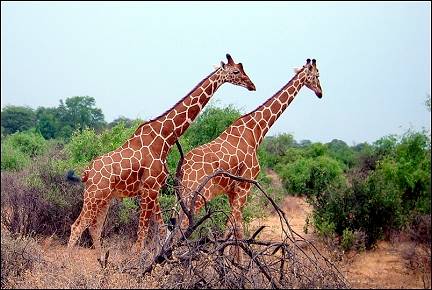
|
If you don't pay attention, even for a second, baboons will grab your food from the table and at night it's better to stay inside your tent, if you don't want to get attacked by a hippo. But most of the time it's just fun, watching game in Kenya. The route of the tour: from Nairobi via Mount Kenya and the Samburu to Lake Nakuru, Lake Baringo, Kerio Valley and Kisii.
Travelogue & photos: Johan Siegers
After a night flight on which we don't get much sleep, we arrive around 6 AM at Nairobi airport. Outside it's still dark. Immigration and custums formalities are done quickly, so we are outside in a short time.
It's beginning to get light and the truck that will transport us in the next three weeks is already waiting for us.
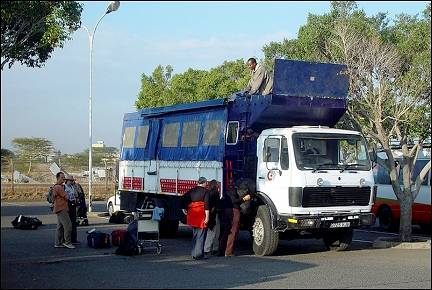
|
What follows is a bumpy ride on roads that would be called "bad" where I come from. Along the road are shabby houses, built with coarse bricks, corrugated iron and recycled wood. This is a time of draught and the red soil flies up around us. We see many people walk along the road.
Mount Kenya
Poisened arrows are very effective
The destination on this first day is a camp site at the foot of Mount Kenya. It's getting clouded and there are even a few raindrops.
Because of sleep deprivation and getting up so early, my biological clock is seriously off and I think that our lunch is dinner. Then it turns out we still have the whole afternoon before us.
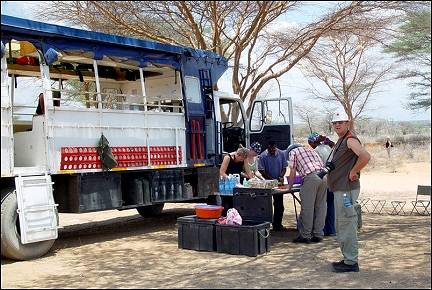
|
After lunch and washing the dishes, a guide takes us for a two-hour walk in the surroundings. He tells us about plants and how they are used by the local population. Some plants are medicinal, others - like henna - are used for dyeing.
There are also poisonous plants. These are used to dip arrows in. Poisoned arrows are very effective because the goal (enemy, prey) only has to be grazed by it. The poison paralyzes the central nerve system. During our walk we also see lots of birds and colobus monkeys.
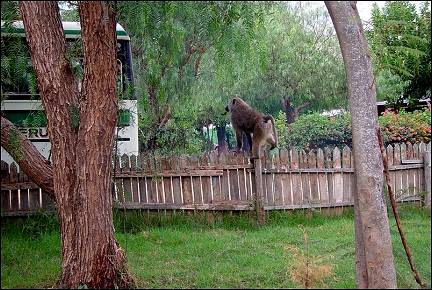
|
Back at the camping site, some baboons have decided to honor us with a visit. Of course, only to steal our food. When the cook doesn't pay attention for a second, one of them grabs a large bunch of bananas from the table. They try to scare away the baboons by throwing rocks at them, but they're back soon.
Samburu
A demonstration jumping straight up
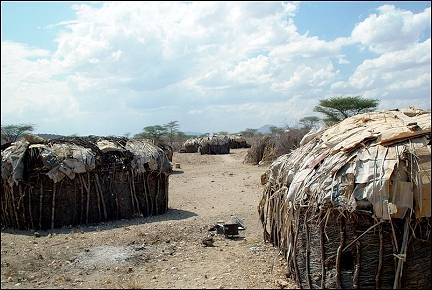
|
The next day we cross the equator. We are shown how water in a drain turns left in the northern hemisphere and a bit farther, in the southern hemisphere, right.
Of course there are the inevitable souvenir shops. I buy two sculptures and a mask. They ask way too much, but I negotiate until it's only one third (probably still too much). And then I am invited to also take a look at "his brother's" shop.
The asphalt road changes into a dusty sand road soon after this. It feels as if every nook and cranny is shaking loose, that's how bad we bump and shake.
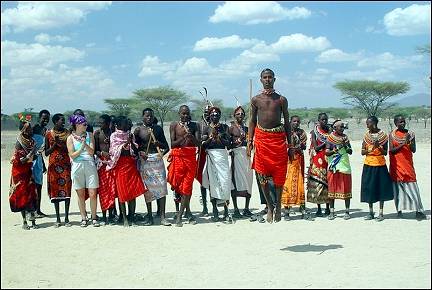
|
We visit a Samburu village. They are related to the Masai. The women greet us with song and the men demonstrate their ability to jump straight up.
We take a stroll through the village. The Samburu live in huts made of tree branches covered with cow dung. Their diet consists of milk, blood and meat. They don't eat fruit. A Samburu can have more than one wife, provided he owns enough cows.
Later they show us how they tap blood from a goat by shooting an arrow in their neck artery. The blood is mixed with milk and serves as food. Goats give blood every three months on average.
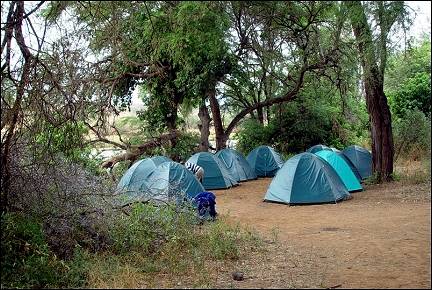
|
We arrive at our camp site, near the river, late in the morning. We have to pitch our tents in a small circle.
We are not supposed to leave our tents at night. If you really need to pee, you have to listen if nothing is walking around the tents and then you have to pee quickly behind your tent. Because we are so close to the river, there is a chance that alligators or hippoes will enter our camp site.
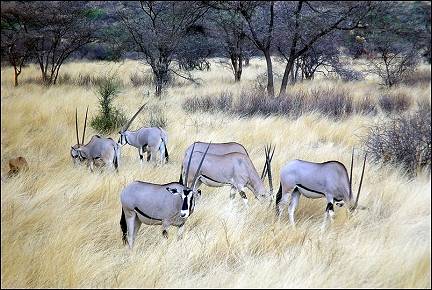
|
In the afternoon we take our first game drive. Soon we see elephants crossing the river near our car. Then two lions, several kinds of antelope and buffalo.
By the end of the afternoon it starts to rain. The local population is happy, because it hasn't rained here in nine months. We, of course, are less than pleased. Our truck's shutters are closed, so we see less. The only upside is that the dust on the roads doesn't fly up anymore.
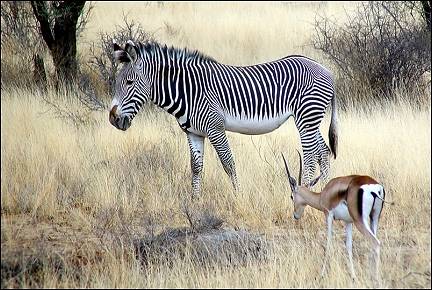
|
After two more game drives the next day, we can add giraffes to our list of animals we've seen. Even two different kinds, judging from their markings. We also see a Gravy zebra and a jaguar, who is scanning the surroundings, lying on a rock.
In the afternoon we go for a swim in the swimming pool of the nearby Samburu Lodge. The water is nice and so is the beer. The clouds have gone and the sun shines again. The temperature is perfect. There are also monkeys around the pool. Fortunately they don't steal our food.
Lake Nakuru
There are thousands of flamengoes here
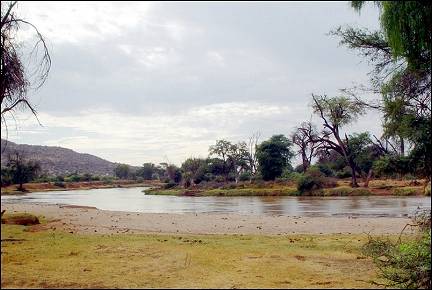
|
At some point during the long ride to Thomson Falls, a group of boys pelts our truck with rocks. Helene, who is part of our travel company, is hit in the head. Head injuries bleed badly, so we see the blood streaming over her face.
Fortunately there happen to be operation-room assistents in our group. They immediately get the first-aid kit. They clean the wound and even stitch it with sterile needles from the first-aid kit.
Tom, our driver, runs after the kids but can't catch them. A villager recognizes the boys from Tom's description and will chide them.
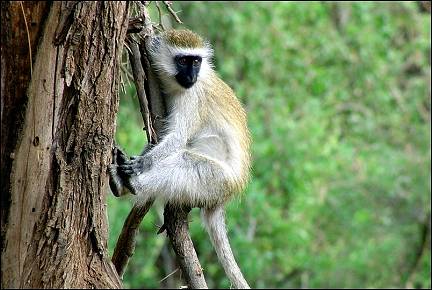
|
First we drive to a panoramic view point that looks out on the Great Rift Valley. It's rather foggy there. During the ride to Nakuru we cross the equator again. We are back in the southern hemisphere. The surroundings here are greener than around Nairobi. The cows are fatter, too.
Nakuru is a small town. The people in my group want to use the internet and I don't, so I'm having a cup of coffee with a samosa (Indian pastry) and after that, I explore the town. By accident I walk toward the souvenirs hawkers. They soon annoy me and I walk away in the opposite direction.
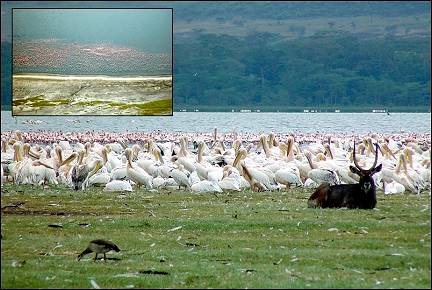
|
I arrive in a street with "regular" stores and a little farther there's a market. Part of it is outdoors, but vegetables, meat and fish are sold indoors, in a seperate part of the market. There are also lots of small stores, actually more like kiosks.
Because I don't have a map with me, I take the wrong street when I leave the market. I notice it looks unfamiliar, so I walk back until I see the bus station. From here I know the way back.
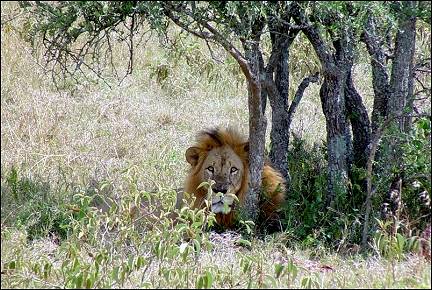
|
We take two more game drives along Lake Nakuru. There are literally thousands of flamengoes here, as well as large numbers of marabus and pelicans. We also spot our first rhinoes. Nearby are herds of buffalo and we see another jaguar and a male lion.
Lake Baringo
When hippoes feel threatened, they may attack
When we stop for lunch, it doesn't take long before a group of people gathers to watch us from a distance.
On the camping site at Lake Baringo, the largest part of our group heads for the swimming pool. With a small group, led by a local guide, we take a walk through the Great Rift Valley.
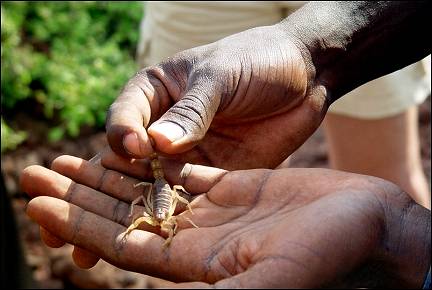
|
This valley runs from the Dead Sea to Beira, Mozambique over a distance of 6,500 km and is only a few hundred meters wide at this point. Our guide first shows us a black scorpion by lifting a stone and later a white one. The black scorpion has pincers to fight with as front legs, but the white one is much more poisonous.
On this site we also have to be careful if we leave our tents at night to go to the bathroom. The lake is nearby and hippoes sometimes enter the camping site to graze. Whatever we do, we have to avoid getting between a hippo and the lake, because that will make it insecure and it will attack.
We start the next day with a boat ride on Lake Baringo. The hippoes are just visible above the water surface.
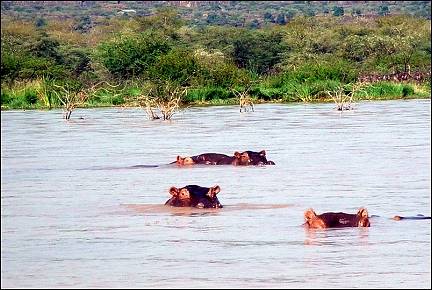
|
The boats keep a distance, because if hippoes feel threatened, they may attack. In the water, however, our boats are faster than the hippoes.
Crocodiles and iguanas are sunbathing on the lakeside. The crocodiles are shy and dash for the water when we get too close.
We see a fisherman in a simple traditional boat. We lure some African fish eagles by throwing pieces of fish in the water. One of them succeeds in picking it up from the water while still flying.
Kerio Valley
Goats and occasionally a cow walk in the streets
On the way to the Kerio Valley we see ostriches. Part of the road was destroyed in a flood. In the mean time, a detour through the brush has developed, because the road won't be repaired any time soon.
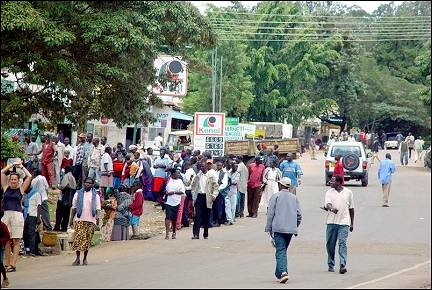
|
We get groceries in the village of Kabernet. Goats and occasionally a cow walk in the streets. As soon as we park our car, some goats seek protection from the sun underneath it.
On our trip to the Kerio Valley we cross the Kerio River, which flows through deeply worn away rocks. We will stay on the next camping site for two nights.
As usual, it begins to rain a bit. This time just when we are pitching our tents. In any case, the tents have never been ready this fast.
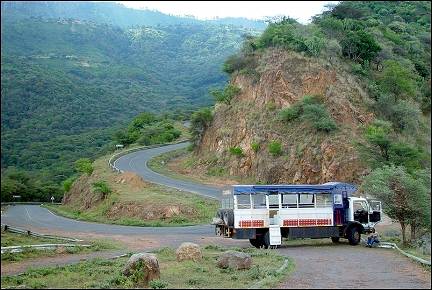
|
We are told to watch out for suspicious bouts of fever. We have been in Kenya for six days now and that is exactly the incubation period of malaria. If the fever lasts longer than 24 hours, you have to be checked for malaria.
The next morning a part of the group goes for a three-hour walking tour, guided by a bird-and-plant expert. Because my muscles still ache from the last walk, I take the morning off. The others tell me later that it was a taxing walk.
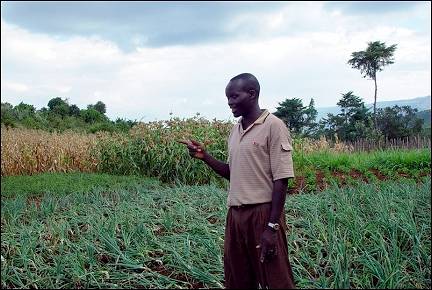
|
Near the camping site is a farm run according to the Dutch model. Everyone told the farmer he was crazy when he started fertilizing his land with cow dung.
But the soil became more fertile and colored from red to black. The white cabbages he grows are bigger than any he grew before. Now he grows different kinds of crop, like corn, onions and oranges. His two (Frysian) cows provide him with fertilizer.
Kisii
Kenyans love speed ramps
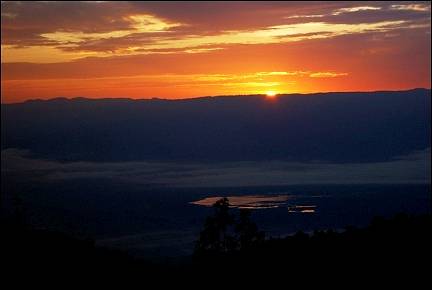
|
On the way to Kisii Africa gets greener. There are also more private cars on the road, which means, I guess, that the population here is not as poor. It's a long drive to Kisii.
Kenyans love speed ramps. There are a few at every village limit, on through roads. Inside villages there are speed ramps every 100 meters. Along the road are tea, coffee and sugarcane plantations.
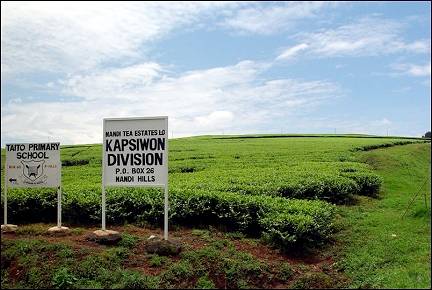
|
We spend the night in a monastery that rents rooms, because rain is expected tonight.
The next day we visit a workshop where sculptures are made of saponite. After the usual (and necessary) negotiations, we buy some. Then we leave for the Tanzanian border.